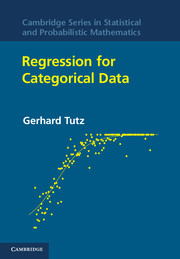Book contents
- Frontmatter
- Contents
- Preface
- 1 Introduction
- 2 Binary Regression: The Logit Model
- 3 Generalized Linear Models
- 4 Modeling of Binary Data
- 5 Alternative Binary Regression Models
- 6 Regularization and Variable Selection for Parametric Models
- 7 Regression Analysis of Count Data
- 8 Multinomial Response Models
- 9 Ordinal Response Models
- 10 Semi- and Non-Parametric Generalized Regression
- 11 Tree-Based Methods
- 12 The Analysis of Contingency Tables: Log-Linear and Graphical Models
- 13 Multivariate Response Models
- 14 Random Effects Models and Finite Mixtures
- 15 Prediction and Classification
- A Distributions
- B Some Basic Tools
- C Constrained Estimation
- D Kullback-Leibler Distance and Information-Based Criteria of Model Fit
- E Numerical Integration and Tools for Random Effects Modeling
- List of Examples
- Bibliography
- Author Index
- Subject Index
2 - Binary Regression: The Logit Model
Published online by Cambridge University Press: 05 June 2012
- Frontmatter
- Contents
- Preface
- 1 Introduction
- 2 Binary Regression: The Logit Model
- 3 Generalized Linear Models
- 4 Modeling of Binary Data
- 5 Alternative Binary Regression Models
- 6 Regularization and Variable Selection for Parametric Models
- 7 Regression Analysis of Count Data
- 8 Multinomial Response Models
- 9 Ordinal Response Models
- 10 Semi- and Non-Parametric Generalized Regression
- 11 Tree-Based Methods
- 12 The Analysis of Contingency Tables: Log-Linear and Graphical Models
- 13 Multivariate Response Models
- 14 Random Effects Models and Finite Mixtures
- 15 Prediction and Classification
- A Distributions
- B Some Basic Tools
- C Constrained Estimation
- D Kullback-Leibler Distance and Information-Based Criteria of Model Fit
- E Numerical Integration and Tools for Random Effects Modeling
- List of Examples
- Bibliography
- Author Index
- Subject Index
Summary
Categorical regression has the same objectives as metric regression. It aims at an economic representation of the link between covariables considered as the independent variables and the response as the dependent variable. Moreover, one wants to evaluate the influence of the independent variables regarding their strength and the way they exert their influence. Predicting new observations can be based on adequate modeling of the response pattern.
Categorical regression modeling differs from classical normal regression in several ways. The most crucial difference is that the dependent variable y follows a quite different distribution. A categorical response variable can take only a limited number of values, in contrast to normally distributed variables, in which any value might be observed. In the simplest case of binary regression the response takes only two values, usually coded as y = 0 and y = 1. One consequence is that the scatterplots look different. Figure 2.1 shows data from the household panel described in Example 1.2. The outcomes “car in household” (y = 1) and “no car in household” (y = 0) are plotted against net income (in Euros). It is seen that for low income the responses y = 0 occur more often, whereas for higher income y = 1 is observed more often. However, the structural connection between the response and the covariate is hardly seen from this representation. Therefore, in Figure 2.1 the relative frequencies for owning a car are shown for households within intervals of length 50. The picture shows that a linear connection is certainly not the best choice.
Information
- Type
- Chapter
- Information
- Regression for Categorical Data , pp. 29 - 50Publisher: Cambridge University PressPrint publication year: 2011
